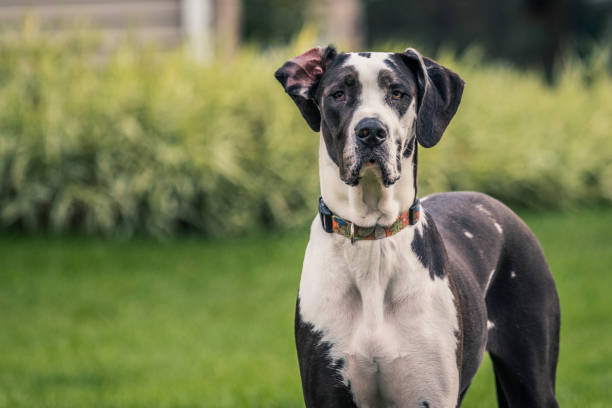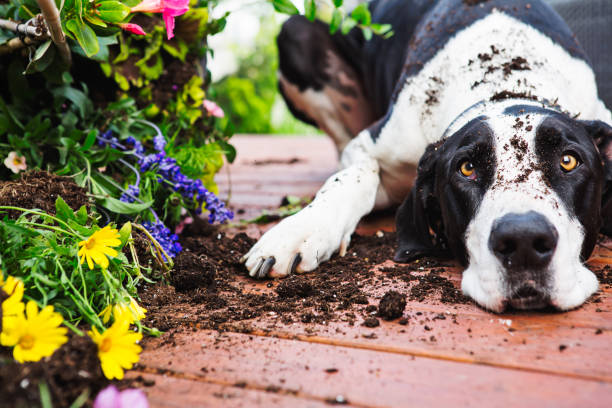The character of the Great Dane is described as good-natured, gentle, and loyal. Her graceful and extremely elegant appearance earned her the nickname “Apollo of the Dogs” because she sometimes looks like a noble statue to the viewer. She is very tolerant towards children and other animals and is quite sociable.
Great Danes Temperament – Being – Character
Temperament: The composure and the tendency to want to please people enable a harmonious coexistence in a family environment. Nevertheless, the dog owner’s consistent appearance must start from the puppy’s legs. After all, most bipeds succumb to the Great Dane in a direct showdown. Sometimes she can be extremely stubborn, special motivation training could help here. With consistent but loving leadership from puppyhood, she is very easy to train.
Since you need to have such a large and spirited dog under control at all times, it is imperative that he obeys your every word and is not aggressive or timid. If the animal moves its immense weight in play or for a territorial reason, the end of the leash is rarely unaffected. This particularly affects dog lovers with little experience in keeping dogs. A bored Great Dane easily gets on the nerves of the owners.

On the other hand, being able to walk without a leash in the dog exercise area gives her a good deal of quality of life. It is up to the dog owner to always have an effect on his four-legged friend and to be able to retrieve him. A mastiff quickly reads tracks in fields and forests and can be tempted to follow them.
With a good upbringing and with the help of successful basic training of the dog, the balancing act succeeds in reconciling the needs of the people and the abilities of the dog. Long hikes should only be tackled when the animal is fully grown. Too much can cause permanent damage to the joints. This applies equally to cyclists or joggers who want to pursue their hobby accompanied by their companion. They gently increase the dog’s performance without overtaxing it.
Since most buyers later want to have a large animal, when buying puppies they should make sure that the young animals are strong and healthy and that the parents have a good character. Unfortunately, the unconditional desire for size can lead to health problems such as deformities in the anatomy, which of course reduces life expectancy. Unfortunately, a Great Dane rarely lives to be more than ten years old, some of them don’t even live to that age.
The Great Dane is a family dog that is wary of strangers. Some specimens are downright territorial and stretch the boundaries at their own discretion. On the other hand, the volume with which the Great Danes want to make themselves heard is extremely pleasant. They bark comparatively quietly, as volume measurements have shown in this regard.
A close bond to her pack is existential for the big one, she doesn’t like long separations. At home, she gets along well with everyone and is open-minded and respectful towards children. However, their sheer size has the potential to inadvertently endanger young people. Again, the owner has a duty to act with foresight.
The Great Dane, known in English as “Great Dane”, belongs to the FCI Group 2 of the Molossians. Its origin can be found in Germany, it owes its foreign name as Dane to the temporarily very low popularity of the word “German”. However, large males can easily reach a weight of 80 kg, the best-known largest Great Dane had a weight of 108 kg a height of 105 cm!
Story
Already from 2200 BC, mastiff-like dogs were depicted on wall drawings, coins, and paintings. It is not certain whether Phoenician traders or Roman legionnaires brought dogs of this type to Central Europe. The Great Dane comes closest to the Alaunt, a hound from the Middle Ages, but without showing the overbite.
In Italy, the Great Danes are still referred to as “Alano” today. The elegant body shape is said to have been created by crossing with scent hounds, and the black and white spots, the harlequin, could also be traced back to scent hounds or shepherd dogs. What is certain is that the Germans and Celts already used mastiff-like dogs to hunt bears and wild boars, but also as war dogs.

In the Middle Ages, the ancestors of today’s Great Dane, the so-called hunting dogs, were used to hunt sows. This was a privilege of the princes and these dogs could be found in almost all European royal and princely houses. In 1592, for example, the Duke of Brunswick is said to have taken a pack of 600 mastiff males with him for a sow hunt.
They were also used to hunt wolves, red deer, and wild boars. Over time, however, they were no longer used for hunting, but as a status symbol for companionship. In the 19th century, more and more rich citizens kept Great Danes and they were one of the first breeds to be recorded in the studbook. Prince Bismarck, the later “Iron Chancellor”, finally made the Great Dane the German national dog, the so-called “Reichshund”, in 1876.
He himself was constantly accompanied and guarded by Great Danes. In the middle of the 19th century, they were also exported to the USA, where they were initially exhibited as Ulmer or Siberian mastiffs. Since they were also trained for man work, they initially received the unjustified reputation of being a very wild breed. Over time, however, the Americans no longer had any problems with the nature of these dogs. A very famous owner at the time was the cowboy William Cody known as “Buffalo Bill”.
In 1877 they were first exhibited in England. Today the Great Dane is used as a watchdog and family dog all over the world. According to the experts, the genome of Irish wolfhounds and mastiffs as well as crossbreeds with sighthounds form the basis for the modern Molosser.